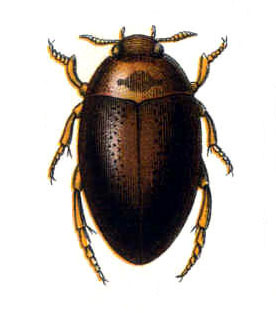| Neohydrocoptus | |
|---|---|
| Scientific classification | |
| Kingdom: | |
| Phylum: | |
| Class: | |
| Order: | |
| Suborder: | |
| Family: | |
| Genus: | Neohydrocoptus Satô, 1972 |
Neohydrocoptus is a genus of beetles in the family Noteridae, containing the following species: [1]

Beetles are a group of insects that form the order Coleoptera, in the superorder Endopterygota. Their front pair of wings are hardened into wing-cases, elytra, distinguishing them from most other insects. The Coleoptera, with about 400,000 species, is the largest of all orders, constituting almost 40% of described insects and 25% of all known animal life-forms; new species are discovered frequently. The largest of all families, the Curculionidae (weevils) with some 83,000 member species, belongs to this order. Found in almost every habitat except the sea and the polar regions, they interact with their ecosystems in several ways: beetles often feed on plants and fungi, break down animal and plant debris, and eat other invertebrates. Some species are serious agricultural pests, such as the Colorado potato beetle, while others such as Coccinellidae eat aphids, scale insects, thrips, and other plant-sucking insects that damage crops.

Noteridae is a family of water beetles closely related to the Dytiscidae, and formerly classified with them. They are mainly distinguished by the presence of a distinctive "noterid platform" underneath, in the form of a plate between the second and third pair of legs. The family consists of about 230 species in 14 genera, and is found worldwide, more commonly in the tropics. They are sometimes referred to as burrowing water beetles.
- Neohydrocoptus aethiopicus (J.Balfour-Browne, 1961)
- Neohydrocoptus africanus (Gschwendtner, 1930)
- Neohydrocoptus angolensis (Peschet, 1925)
- Neohydrocoptus badicus (Guignot, 1956)
- Neohydrocoptus bivittis (Motschulsky, 1859)
- Neohydrocoptus bosschae (Régimbart, 1892)
- Neohydrocoptus bradys (Guignot, 1955)
- Neohydrocoptus cunctans (Guignot, 1953)
- Neohydrocoptus dermotylus (Guignot, 1953)
- Neohydrocoptus distinctus (Wehncke, 1883)
- Neohydrocoptus freyi (J.Balfour-Browne, 1961)
- Neohydrocoptus frontalis (Régimbart, 1899)
- Neohydrocoptus garambanus (Guignot, 1958)
- Neohydrocoptus grandis (J.Balfour-Browne, 1961)
- Neohydrocoptus jaechi (Wewalka, 1989)
- Neohydrocoptus koppi (Wehncke, 1883)
- Neohydrocoptus megas (Omer-Cooper, 1957)
- Neohydrocoptus opatrinus (Régimbart, 1892)
- Neohydrocoptus placidus (Guignot, 1955)
- Neohydrocoptus rubescens (Clark, 1863)
- Neohydrocoptus rufulus (Motschulsky, 1859)
- Neohydrocoptus scapularis (Régimbart, 1899)
- Neohydrocoptus seriatus (Sharp, 1882)
- Neohydrocoptus sharpi (Wehncke, 1883)
- Neohydrocoptus subfasciatus (Sharp, 1882)
- Neohydrocoptus subvittulus (Motschulsky, 1859)
- Neohydrocoptus timidus (Guignot, 1956)
- Neohydrocoptus uellensis (Guignot, 1953)









